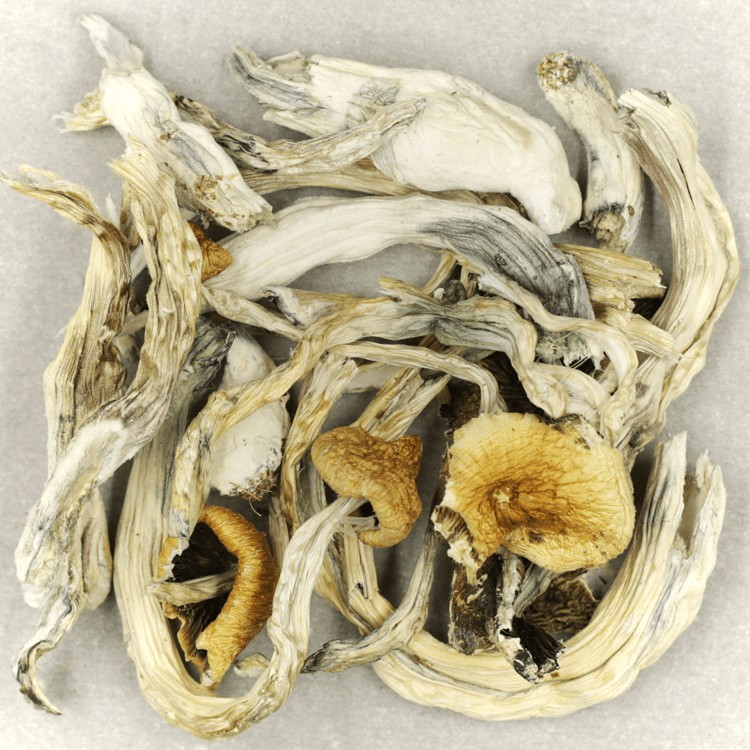The Treasure Coast Mushroom is a renowned strain of psychedelic mushrooms, praised for its potential to boost creative thinking and inspire original ideas.
Writers often encounter a creative stagnation, which is a difficulty in generating or executing fresh ideas.
Occasionally, this creative stagnation stems from psychological aspects like fear of rejection, the pursuit of perfection, or external stress. There are multiple methods to overcome these challenges, but for some, shrooms may offer a more immediate and significant pathway to creative inspiration.

Key Takeaways:
- Treasure Coast mushrooms enhance creativity by promoting divergent thinking.
- The high psilocybin concentration temporarily disrupts the brain’s default mode network, improving spontaneous thought generation and introspection.
- Psilocybin can enhance creativity by improving the ability to create new ideas, even a week after consumption.
Getting to Know Treasure Coast Mushrooms:
Known scientifically as Psilocybe cubensis, these mushrooms originate from the Treasure Coast region of Florida, which inspired their name. They are recognized for their swift growth.
- The mushrooms feature a distinct caramel to golden brown cap that can expand to a diameter of 5 centimetres.
- The cap has undulating edges and looks like a small sombrero.
- Underneath the cap is a dense layer of gills, varying from a light yellow to a deeper brown color.
- Upon reaching maturity, it leaves behind a purple-black spore print.
- The stem is firm and resilient, ranging from 5 to 15 centimetres in height. It often turns blue when touched, which is more than a visual characteristic; it’s a chemical reaction signaling the presence of psilocin, a highly potent psychoactive compound that affects the brain.
Note: Leucistic strains are less pigmented variants that can be produced upon discovery. They strikingly resemble the original strain in appearance.
Effectiveness and Influence
While it may not rival the potency of strains such as Penis Envy, it still offers an extraordinary psychedelic experience. Users have reported typical psilocybin effects, including mood changes, enhanced perception, and profound insights.
A Brief History within Cultural Contexts
Historically, the consumption of mushrooms can be traced back to ancient societies, with evidence of their use in spiritual and healing rituals in regions from Mesoamerica to modern-day Canada.
Indigenous communities utilized these mystical fungi in ceremonies to foster deep spiritual connections, harnessing their visionary properties for healing and strengthening communal bonds.
Scientific Understanding of Psilocybin’s Effect on Creativity
Recent research published in the Journal of Transnational Psychiatry utilized ultrahigh-field multimodal brain imaging to study these effects in real-time. The study found that psilocybin increased connectivity within and between various brain networks, which correlated with a surge in “spontaneous” creativity.
Altering Perception and Cognitive Functions
After consumption, psilocybin peaks in the bloodstream (15.61 ng/mL) approximately 80 minutes later, leading to reported alterations in sensory perception and cognitive abilities.
- Colours become more vivid
- Objects may seem to pulsate or morph
- Changes in spatial awareness can occur
An increase in glutamate concentrations was observed within the medial prefrontal cortex, a region linked with complex thinking and decision-making processes. In contrast, glutamate levels decreased in the hippocampus, a region tied to memory.
Research Conclusions
Does psilocybin truly enhance creativity, or is it merely The Journal of Transnational Psychiatry investigated whether creativity is an innate ability or a learned skill by examining “spontaneous” and “deliberate” creativity.
Spontaneous creativity refers to sudden, unpolished ideas that emerge without warning, while deliberate creativity involves focused problem-solving and task-oriented thought processes. Researchers have noticed that spontaneous thinking tends to flourish, while deliberate thinking is temporarily suppressed.
- Using tasks such as the Picture Concept Task (PCT) and the Alternative Uses Task (AUT), researchers assessed participants’ originality, achieving impressively high reliability scores of 0.95 and 0.91, respectively.
- After consuming the substance, participants reported a heightened sense of insightfulness, suggesting an enhanced access to new ideas.
- Participants’ task-specific thoughts decreased, likely due to the brain’s newly formed, less restricted connections overshadowing the normal, linear problem-solving process.
- Participants were able to generate more unique ideas up to a week after exposure, implying that the brain’s reconfiguration could have a long-term effect on enhancing originality beyond the period of consumption.
Divergent Thinking and Problem-Solving
Divergent thinking, the capacity to generate diverse solutions to a single problem, is a major factor in creativity. The compound helps break down conventional thinking barriers, allowing the brain to consider possibilities that would normally be disregarded as nonsensical or improbable.
Psychedelic substances in sufficient doses to cause hallucinations target the brain’s serotonin 5-HT2A receptors, disrupting habitual thought patterns and enhancing cognitive flexibility and divergent thinking. This process could establish a route for unlocking creativity.
Guidelines for Writers Interested in Experimenting with Treasure Coast Mushrooms
Feeling caught in a creative rut? You might want to consider the potential creativity boost that mushrooms could provide. For those new to this, starting with small doses is recommended to safely experience the creativity-boosting effects of this fascinating substance.
Dosage Recommendations for Creative Exploration
| Microdose (0.1 – 0.3 grams) | Although this won’t trigger visual effects, it can enhance focus, mood, and creativity without disturbing your daily routine. |
| Low Dose (0.5 – 1 gram) | This dosage may boost distortions in sensory perception and mood while causing minor distortions. |
| Moderate Dose (1 – 2 grams) | At this dosage level, expect amplified effects such as visual distortions, an enhanced feeling of interconnectedness, and heightened emotional responses. |
The Importance of “Set” and “Setting”
- Set (Mindset): Reflect on your goals before starting. Are you hoping to spark innovative ideas? Delve into your character’s mindset. Enter the session with an open mind, prepared for potential psychological exploration.
- Setting (Environment): Choose a comfortable and familiar setting. Think about a peaceful room, perhaps equipped with mood-enhancing elements such as soft lighting, calming instrumental music, and a notepad at hand. If possible, let a reliable friend know about your session or ask them to be there as a sober, supportive “trip-sitter”, just in case.
Techniques to Consider While Under the Influence
Free-Flow Writing
Psilocybin often eases the traditional filters and promotes the flow of thoughts. This includes writing down anything that comes to mind without self-judgment, analysis, or concern about its logical flow.
Continuous Association
An interesting exercise includes writing down words as they come to mind, even if they seem unrelated. This could potentially connect separate thoughts, so jot down any words that arise, follow the train of thoughts wherever it goes, and see if you can uncover new themes or patterns for your work.
Dialogue with Characters
If you’re writing fiction, try initiating a direct conversation with your characters. This can blur the line between the creator and the creation, allowing you to dive into different viewpoints. Ask questions like, “What do you want to do next?” or “What are you afraid of?” Record their “responses” as they come to you.
Wrapping Up Your Visionary Journey
As a member of the Psilocybe cubensis family, Treasure Coast possesses attributes that are favorable to the creative process, fostering enhanced introspection, sensory perception, and openness.
For writers, this isn’t
It’s more than just momentary inspiration; it’s about harnessing a tool that can help surmount creative barriers, augment sensory nuances, and encourage distinct modes of expression. Remember, psilocybin, accessible from a shroom online, is an enhancer, not a substitute for innate ability or consistent effort.
Frequently Asked Questions
How does one reflect on and incorporate the psilocybin experience?
After the session, writers should scrutinize their notes or captured thoughts and pinpoint any recurring themes, symbols, or feelings that resonate with their work. Keeping a “trip journal” and summarizing newly discovered ideas or emotional shifts can assist them in comprehending their experience.
What is the length of the creative effects of Treasure Coast mushrooms?
The effects last for 4-6 hours, but the creativity boost might extend for several days. Amplified creativity, particularly in the creation of original ideas, can be sustained even a week post-session. This “afterglow” phase, marked by increased receptivity and cognitive adaptability, offers an ideal opportunity to refine or broaden the ideas explored during the experience.
Are there any notable writers or artists who have used psychedelics for creative stimulation?
The author Aldous Huxley delved into mescaline and later LSD, documenting his experiences in The Doors of Perception. Cultural revolution authors like Allen Ginsberg and Jack Kerouac are also recognized for their psychedelic use, as well as musicians such as The Beatles.
While they didn’t specifically use Treasure Coast, their work attests to the lasting bond between psychedelics and creativity in the spheres of art and literature.





